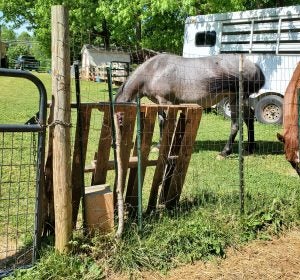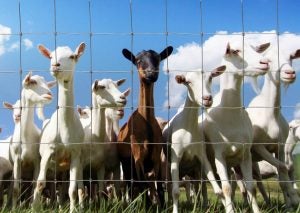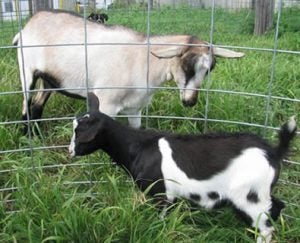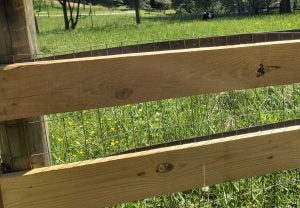If there’s something I repair more than anything else on my farm, it’s the goat fencing. The folks at a farm supply store once told me that if water can get through your fence, then so can a goat. Truer words have rarely been spoken. So if nothing works, is there even such as thing as a best fence for goats? Well, yes and no.
Nothing will be perfect. Let’s make that clear.
But some types of fencing are certainly better than others. The tricky thing with a lot of goat breeds is that they’re not shy about testing a fence, so they’ll push on it and knock the staples out, or for a welded wire fence, they’ll often just break it apart. It’s not always malicious — sometimes they are just aggressively scratching themselves on the fencing. But it’s definitely frustrating. Add to that the fact that some breeds will simply jump over the fence, and it’s no wonder that so many goat owners look for solutions to this ongoing problem.
Be honest: If you’re a goat owner, you’ve had this kind of fencing blooper at one point or another, right?

So we’re going to look at three of our favorite options for the best fence for goats available. Be sure that whatever fencing system you use is at least four feet tall to prevent goats from going over top of it, and any mesh fencing you buy should have squares no bigger than 4-by-4 inches. Tractor Supply’s interview with a goat expert strongly warns against using spacing that’s any bigger than that, specifically saying that a 6-inch square is a “goat-killer.”
“They can sometimes strangle in there, but the biggest thing is predators. They’re coyote bait,” the expert, Carol Rochester, says.
To get a real in-depth look at building fencing and some overall things to consider, this fencing guide for farms is worth the read.
But to get into the weeds with the best fence for goats (wait, my goats ate all my weeds 🙂 ), here’s what we recommend:

Red Brand Square Deal Goat & Sheep Wire Fence
The mesh Red Brand Square Deal Goat & Sheep Wire Fence provides safe containment for goats and other livestock and measures 48 inches tall and stretches 330 feet long. The mesh gaps measure 4-by-4 inches, which is ideal for goals, but be aware that this means more wire is used, and it tends to be more costly than 6-by-6 gaps or something bigger. In the end, though, it’s well worth it! The 4-inch squares help prevent injury by keeping animals from sticking their heads out of the fence, and the fencing is flexible on impact.
Red Brand’s Square Deal Knot reduces the amount of buckling or sagging from a fence like this, while also providing extra strength and rigidity with flexibility for ideal installation over hilly terrain. The smooth side of Square Deal Knot also prevents injury to goats — especially ones that like to rub the fence to get to that hard-to-reach itchy spot.
This low-carbon steel metal wire fence (which has 10-gauge top/bottom wire and 12.5-gauge filler wire) also helps to keep many predators out, and the Class 1 galvanization helps prevent rusting. If you did your job installing this fence and it’s taut in all spots, this should do a nice job of keeping your goats in place.
Sheep/Goat Feedlot Panel
If you’re working in a smaller and relatively flat area, feedlot panels could be a good option for you. They’re strong, and you don’t have to worry about them bending or buckling when your goats inevitably put their front hoofs up at the highest points. They also won’t collapse or have issues when animals rub against them.
Feedlot panels are also an exceptional option if you need to separate animals inside a pen.
They are light weight and flexible, making them easy to maneuver. The panels have 1-piece welded construction, so they’re low-maintenance, and they’re usually about 4 gauge wire. They have various spacing options, but usually you’re lookin at either 4-by-4 inches or 4-by-3 inches. Definitely look for panels that are at least 4 feet tall, and 16 feet long panels are pretty standard.
Combination Welded Wire/3-Board Fence
Truth be told, this is the only type of fencing that has been truly close to bombproof when it comes to goats. But it’s expensive, and it took several years to get the money and materials together to make it all work. This isn’t recommended for huge plots of lands because of the cost, but especially if you have horses in pastures adjacent to goats, this could be a great and effective solution.
Because our goats haven’t been disbudded, we’ve gone with 2-by-4-inch wire — we found it was better when it came to keeping the animals from getting their horns caught between the slats. And we were able use to welded instead of woven here because of the added protection of having the boards in place (it definitely saved us money to go that route). There’s almost no “give” at any part of the fencing because of how the wire lays relatively flat against the boards.
The boards themselves are simple 1-by-6-inch rough cuts, while the wire portion is YARDGARD Welded Wire Fence.
Why do goats escape from fences?
Goats are curious animals, so they won’t hesitate to test a fence or even to see if they can jump over it. But sometimes, it’s almost an accident that they escape. Goats can be itchy animals, especially with the insects and other critters that can get into a goat’s coat while romping in the brush. So as they scratch themselves on the fencing, they can break the fence apart and inadvertently rip out your carefully placed nails and staples.
It’s also important to keep goats entertained. Have some toys or a makeshift playset (with old tires and all) for them to occupy themselves with. That’ll make them less mischievous around the fencing. Goats are also herd animals, so they are happier in groups and, again, less likely to wander off to test your fence craftmanship than if they were alone.
How tall should a fence be for goats?
The recommended height for a goat fence is 4 feet (48 inches) tall. This is enough that most goats won’t be able to jump over it — and are less likely to injure themselves trying. Taller fences work fine, too, but that’s usually overkill, especially for the added costs involved.
Be considerate of your post spacing, as well, because if they’re spaced too far apart, that could cause parts of your fence to sag, especially if you’re using T-posts. The spacing of the posts will depend on the gauge of your fence and what tools you have at your disposal to truly tighten the fence well.
Editor’s recommendations
Here’s some suggested reading for people interested in goats and fence-building.
- Basics of goat horns and how to handle them
- The ultimate guide to planning your farm fence
- Goat yoga: The quirky way to connect with farm life
We are committed to finding, researching, and recommending the best products. We earn commissions from some purchases you make using the retail links in our product reviews. Learn more about how this works.




